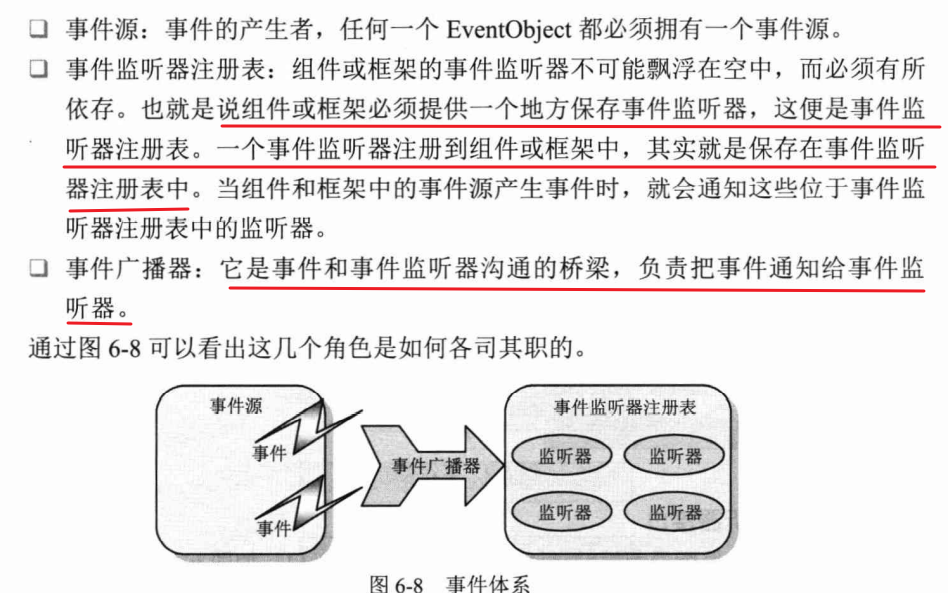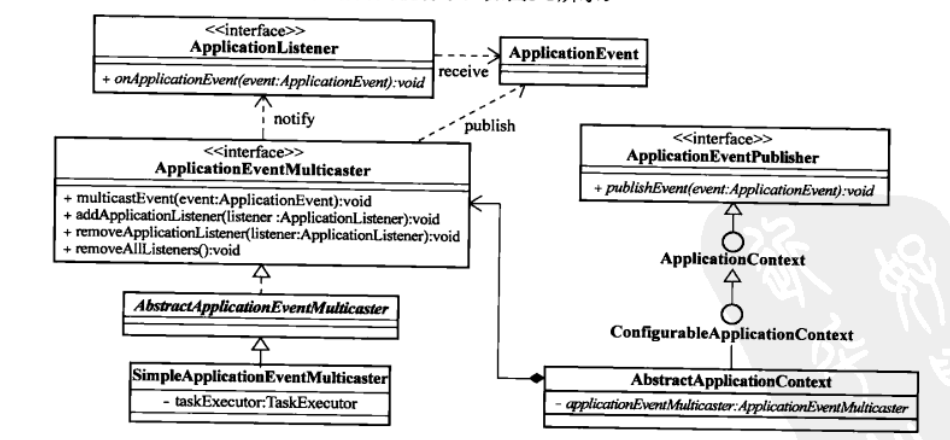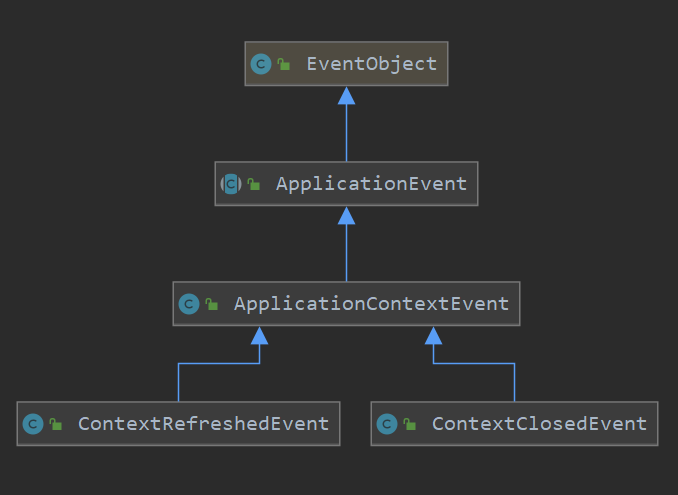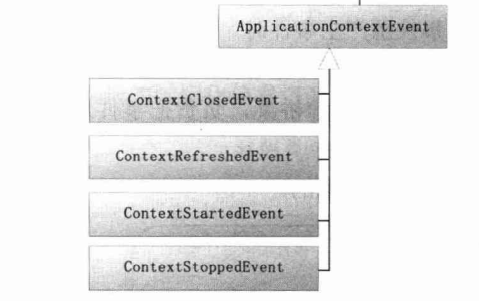Spring學習筆記(4)Spring 事件原理及其應用
在 JDK 中已經提供相應的自定義事件釋出功能的基礎類:
java.util.EventObject類 :自定義事件型別java.util.EventListener介面:事件的監聽器
首先了解幾個概念:

Spring 事件類結構

1. 事件類
事件類也就是定義傳送的內容,比如可以通過繼承ApplicationContextEvent來自定義一個特定事件類。

1.1 ApplicationEvent類
首先是繼承 EventObject的ApplicationEvent,通過source來指定事件源:
public abstract class ApplicationEvent extends EventObject {
/**
* Constructs a prototypical Event.
*
* @param source The object on which the Event initially occurred.
* @throws IllegalArgumentException if source is null.
*/
public ApplicationEvent(Object source) {
super(source);
}
}
1.2 ApplicationContextEvent類
是主要的容器事件,它有容器啟動、重新整理、停止以及關閉各種事件的子類。
public class ApplicationContextEvent extends ApplicationEvent {
/**
* Constructs a prototypical Event.
*
* @param source The object on which the Event initially occurred.
* @throws IllegalArgumentException if source is null.
*/
public ApplicationContextEvent(Object source) {
super(source);
}
/**
* Get the <code>ApplicationContext</code> that the event was raised for.
*/
public final ApplicationContext getApplicationContext() {
return (ApplicationContext) getSource();
}
}
public class ContextClosedEvent extends ApplicationContextEvent{
/**
* Constructs a prototypical Event.
*
* @param source The object on which the Event initially occurred.
* @throws IllegalArgumentException if source is null.
*/
public ContextClosedEvent(Object source) {
super(source);
}
}
public class ContextRefreshedEvent extends ApplicationContextEvent{
/**
* Constructs a prototypical Event.
*
* @param source The object on which the Event initially occurred.
* @throws IllegalArgumentException if source is null.
*/
public ContextRefreshedEvent(Object source) {
super(source);
}
}
我們可以通過繼承該類來實現,特定的事件型別需求,比如要實現一個郵件傳送事件。只需要繼承ApplicationContextEvent即可:
public class MailSendEvent extends ApplicationContextEvent {
private String msg;
public MailSendEvent(Object source, String msg) {
super(source);
this.msg = msg;
}
public String getMsg() {
return msg;
}
public void setMsg(String msg) {
this.msg = msg;
}
}
同時ApplicationContextEvent也有特定的幾個子類,來表示容器啟動、重新整理、停止以及關閉事件:

2.事件監聽器
事件監聽器介面中,只定義了一個方法:onApplicationEvent(E event)該方法接收ApplicationEvent事件物件,在該方法中編寫事件的響應處理邏輯。
public interface ApplicationListener<E extends ApplicationEvent> extends EventListener {
/**
* 接收ApplicationEvent 事件物件
* 在該方法中編寫事件的響應處理邏輯
* @param event
*/
void onApplicationEvent(E event);
}
我們同樣也可以實現該介面來實現特定的事件監聽器功能,比如郵件傳送的監聽器:
public class MailSenderListener implements ApplicationListener<MailSendEvent> {
@Override
public void onApplicationEvent(MailSendEvent event) {
System.out.println("郵件傳送器的 resource:" + event.getSource() + "郵件傳送器的 msg:" + event.getMsg());
}
}
3.事件廣播器
事件廣播器負責將事件通知監聽器登入檔中的事件監聽器,然後再由事件監聽器分別對事件進行響應。Spring中定義瞭如下介面:

public interface ApplicationEventMulticaster {
/**
* 新增事件監聽器
* @param listener
*/
void addApplicationListener(ApplicationListener<?> listener);
/**
* 移除事件監聽器
* @param listener
*/
void removeApplicationListener(ApplicationListener<?> listener);
/**
* 廣播事件
* @param event
*/
void multicastEvent(ApplicationEvent event);
}
及其簡單實現類SimpleApplicationEventMulticaster:
public class SimpleApplicationEventMulticaster extends AbstractApplicationEventMulticaster{
public SimpleApplicationEventMulticaster(BeanFactory beanFactory) {
setBeanFactory(beanFactory);
}
/**unchecked 表示告訴編譯器忽略指定的警告,不用再編譯完成後出現警告資訊*/
@SuppressWarnings("unchecked")
@Override
public void multicastEvent(ApplicationEvent event) {
for (ApplicationListener applicationListener : getApplicationListeners(event)) {
applicationListener.onApplicationEvent(event);
}
}
}
4.事件釋出者
它本身作為事件源,會在合適的時點,將相應事件釋出給對應的事件監聽器:
public interface ApplicationEventPublisher {
/**
* 通知監聽者並行布事件
* @param event
*/
void publishEvent(ApplicationEvent event);
}
在Spring容器事件中,ApplicationContext介面定義繼承了ApplicationEventPublisher介面,所以實際上AbstractApplicationContext在事件中承擔了事件釋出者的角色。
但是在實際上具體實現事件的釋出和事件監聽器註冊方面,將功能轉接給ApplicationEventMulticaster介面,最終具體實現則放在AbstractApplicationEventMulticaster的實現類中:

Spring 事件類的應用
那麼在Spring中,事件類到底是如何執行的呢?首先我們會在xml組態檔中設定相應的ApplicationListener型別的監聽器,因此在容器啟動後,這些型別的bean會被ApplicationContext容器所識別,它們負責監聽容器內釋出的對應的ApplicationEvent型別的事件。
<bean class="cn.ethan.springframework.test.event.ContextRefreshedEventListener"/>
<bean class="cn.ethan.springframework.test.event.MailSenderListener"/>
<bean class="cn.ethan.springframework.test.event.ContextClosedEventListener"/>
在AbstractApplicationContext的refresh()方法中可以看到自動註冊的內容:
public void refresh() throws BeansException {
// 6. 初始化事件釋出者
initApplicationEventMulticaster();
// 7. 註冊事件監聽器
registerListeners();
// 9. 釋出容器重新整理完成事件
finishRefresh();
}
private void initApplicationEventMulticaster() {
ConfigurableListableBeanFactory beanFactory = getBeanFactory();
applicationEventMulticaster = new SimpleApplicationEventMulticaster(beanFactory);
beanFactory.registerSingleton(APPLICATION_EVENT_MULTICASTER_BEAN_NAME, applicationEventMulticaster);
}
private void registerListeners() {
Collection<ApplicationListener> applicationListeners = getBeansOfType(ApplicationListener.class).values();
for (ApplicationListener listener : applicationListeners) {
applicationEventMulticaster.addApplicationListener(listener);
}
}
private void finishRefresh() {
publishEvent(new ContextRefreshedEvent(this));
}
public void publishEvent(ApplicationEvent event) {
applicationEventMulticaster.multicastEvent(event);
}
所以在ApplicationContext容器啟動時,會自動註冊EventListener型別的 Bean,一旦檢測到有ApplicationContextEvent型別的事件釋出,將通知這些註冊到容器的EventListener
應用範例
下面將構建一個傳送郵件的Spring事件範例:
1. 郵件傳送事件MailSendEvent
public class MailSendEvent extends ApplicationContextEvent {
private String msg;
public MailSendEvent(Object source, String msg) {
super(source);
this.msg = msg;
}
public String getMsg() {
return msg;
}
}
2.郵件傳送事件監聽器MailSendListener(郵件傳送事件)、ContextRefreshedEventListener(容器重新整理事件) 和 ContextClosedEventListener(容器關閉事件)
public class MailSenderListener implements ApplicationListener<MailSendEvent> {
@Override
public void onApplicationEvent(MailSendEvent event) {
System.out.println("郵件傳送器的 resource:" + event.getSource() + "郵件傳送器的 msg:" + event.getMsg());
}
}
public class ContextClosedEventListener implements ApplicationListener<ContextClosedEvent> {
@Override
public void onApplicationEvent(ContextClosedEvent event) {
System.out.println("關閉事件:" + this.getClass().getName());
}
}
public class ContextRefreshedEventListener implements ApplicationListener<ContextRefreshedEvent> {
@Override
public void onApplicationEvent(ContextRefreshedEvent event) {
System.out.println("重新整理/開啟事件:" + this.getClass().getName());
}
}
這時,將監聽器們注入xml檔案中:
<bean class="cn.ethan.springframework.test.event.ContextRefreshedEventListener"/>
<bean class="cn.ethan.springframework.test.event.MailSenderListener"/>
<bean class="cn.ethan.springframework.test.event.ContextClosedEventListener"/>
3.郵件傳送事件釋出者
事件釋出者ApplicationEventPublisher,因為前面提到,applicationContext繼承了ApplicationEventPublisher,而applicationContext將事件釋出功能委託給了ApplicationEventMulticaster,容器在啟動開始就會檢查是否存在名稱為applicationEventMulticaster的 ApplicationEventMulticaster物件範例,如果有就使用提供的實現,沒有則預設初始化一個SimpleApplicationEventMulticaster作為將會使用的ApplicationEventMulticaster
/**
* @description: 實現了事件監聽器的管理功能
* @author: wjw
* @date: 2022/7/9
*/
public abstract class AbstractApplicationEventMulticaster implements ApplicationEventMulticaster, BeanFactoryAware {
public final Set<ApplicationListener<ApplicationEvent>> applicationListeners = new LinkedHashSet<>();
private BeanFactory beanFactory;
@Override
public void addApplicationListener(ApplicationListener<?> listener) {
applicationListeners.add((ApplicationListener<ApplicationEvent>) listener);
}
@Override
public void removeApplicationListener(ApplicationListener<?> listener) {
applicationListeners.remove(listener);
}
@Override
public void setBeanFactory(BeanFactory beanFactory) throws BeansException {
this.beanFactory = beanFactory;
}
/**
* 獲得監聽器
* @param event
* @return
*/
protected Collection<ApplicationListener> getApplicationListeners(ApplicationEvent event) {
LinkedList<ApplicationListener> allListeners = new LinkedList<>();
for (ApplicationListener<ApplicationEvent> listener : allListeners) {
if (supportsEvent(listener, event)) {
allListeners.add(listener);
}
}
return allListeners;
}
protected boolean supportsEvent(ApplicationListener<ApplicationEvent> applicationListener, ApplicationEvent event) {
Class<? extends ApplicationListener> listenerClass = applicationListener.getClass();
/**根據不同範例化型別,判斷後獲取對應目標 class*/
Class<?> targetClass = ClassUtils.isCglibProxyClass(listenerClass) ? listenerClass.getSuperclass() : listenerClass;
Type genericInterface = targetClass.getGenericInterfaces()[0];
Type actualTypeArgument = ((ParameterizedType) genericInterface).getActualTypeArguments()[0];
String className = actualTypeArgument.getTypeName();
Class<?> eventClassName;
try {
eventClassName = Class.forName(className);
} catch (ClassNotFoundException e) {
throw new BeansException("wrong event class name: " + className);
}
return eventClassName.isAssignableFrom(event.getClass());
}
}
public class SimpleApplicationEventMulticaster extends AbstractApplicationEventMulticaster{
public SimpleApplicationEventMulticaster(BeanFactory beanFactory) {
setBeanFactory(beanFactory);
}
/**unchecked 表示告訴編譯器忽略指定的警告,不用再編譯完成後出現警告資訊*/
@SuppressWarnings("unchecked")
@Override
public void multicastEvent(ApplicationEvent event) {
for (ApplicationListener applicationListener : getApplicationListeners(event)) {
applicationListener.onApplicationEvent(event);
}
}
}
4.測試驗證
public void test_event() {
ClassPathXmlApplicationContext applicationContext = new ClassPathXmlApplicationContext("classpath:spring.xml");
applicationContext.publishEvent(new CustomEvent(applicationContext, 110L, "test!"));
System.out.println("-----------------------------------------------------------------");
applicationContext.publishEvent(new MailSendEvent(applicationContext, "郵件傳送測試"));
applicationContext.registerShutdownHook();
}
重新整理/開啟事件:cn.ethan.springframework.test.event.ContextRefreshedEventListener$$EnhancerByCGLIB$$2e5c458
-----------------------------------------------------------------
郵件傳送器的 resource:cn.ethan.springframework.context.support.ClassPathXmlApplicationContext@5f2050f6郵件傳送器的 msg:郵件傳送測試
關閉事件:cn.ethan.springframework.test.event.ContextClosedEventListener$$EnhancerByCGLIB$$fbc2c978